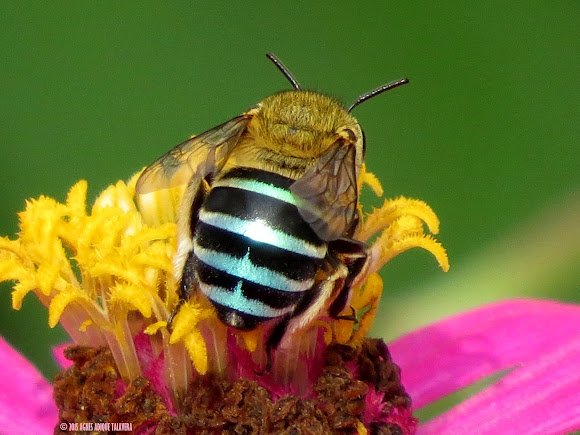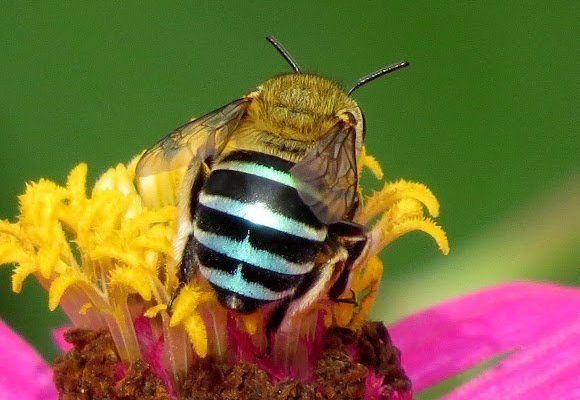
Blue Banded Bees, known scientifically as *Amegilla* species, are native to Australia and some parts of Southeast Asia. They’re not just another pretty face; these bees play a crucial role in pollination, which is vital for our food systems. Think of them as nature’s tiny workers, busily going about their tasks while helping the plants grow. So, if you’re curious about these fascinating creatures, let’s dive into some interesting facts that will surely impress you!
What Makes the Blue Banded Bee Unique?
One of the first things you’ll notice about Blue Banded Bees is their vibrant coloration. Unlike the ordinary bees we commonly see, these bees have distinct blue bands on their bodies. This unique coloring isn’t just for show; it helps them stand out and attract mates. Their shiny blue stripes can vary in color intensity, depending on the individual, which makes each bee look a little different.
Another fascinating aspect of these bees is their buzz pollination technique. While many bees gather pollen by simply landing on flowers, Blue Banded Bees do something a bit more complex. They vibrate their bodies while clinging to flowers, which releases pollen more effectively. This technique is especially beneficial for flowers like tomatoes and blueberries, which need that extra help to ensure proper fertilization. It’s like they have a secret trick up their sleeves to make sure the plants thrive!
Habitat and Lifestyle
Blue Banded Bees are typically found in a range of environments, from urban gardens to wildflower meadows. They thrive in areas rich in flowering plants, as these provide essential food sources. You might wonder why they prefer certain habitats. Well, these bees are solitary creatures, meaning they don’t live in hives like honeybees. Instead, each female bee builds and maintains her own nest—usually in soft, sandy soils where she can create small tunnels.
These nests are quite fascinating. The female bee collects pollen and nectar, forms small balls, and lays her eggs in the tunnel before sealing it off. When the eggs hatch, the young bees have everything they need to start their lives. This solitary lifestyle means that every Blue Banded Bee works hard for their own survival, unlike social bees that share duties within a colony.
Diet: What Do They Eat?
The diet of Blue Banded Bees mainly consists of nectar and pollen from various flowers. Their long tongues allow them to reach deep into flowers, where they collect nectar efficiently. You might be surprised to learn that these bees are especially fond of native Australian plants, but they also visit many exotic plants. This preference makes them key players in the success of local ecosystems, as they help pollinate a broad range of plants.
For these bees, a well-balanced diet is crucial. They need the right mix of nutrients from different flowers to stay healthy and productive. The diversity of their diet helps improve their resilience against disease and environmental changes. If you’re thinking of attracting Blue Banded Bees to your garden, consider planting local native flowers that bloom at different times. This ensures that your little visitors have a consistent food supply throughout the season.
How They Benefit the Environment
You might not realize it, but Blue Banded Bees play a vital role in your garden—and beyond. As pollinators, they help plants reproduce by spreading pollen from one flower to another. This process is essential for producing fruits, seeds, and vegetables. Without these little bees, our food systems would struggle.
Moreover, by pollinating native plants, Blue Banded Bees support biodiversity. Healthy ecosystems rely on diverse plant life, which in turn supports various animal species. By attracting and protecting these bees, you’re contributing to the well-being of countless other creatures. It’s a beautiful cycle of life that shows just how interconnected everything is in nature.
Challenges Facing Blue Banded Bees
Like many bee species, Blue Banded Bees face several challenges. Habitat loss is one of the biggest threats. As urbanization increases and natural habitats are destroyed, these bees lose their homes and food sources. Climate change also impacts their lifecycle and the availability of flowers. It’s essential to recognize these challenges and consider ways to help these little guys thrive.
Pesticides are another concern. While they may be effective for pest control, they can also harm beneficial insects like Blue Banded Bees. It’s vital for gardeners and farmers to adopt bee-friendly practices, such as using organic methods and reducing chemical use. By taking these small steps, we can help create a more welcoming environment for our buzzing friends.
Fun Facts About Blue Banded Bees
Let’s wrap up with some fun facts that will make you appreciate the Blue Banded Bee even more:
- Hummingbird-like Flight: They can hover in mid-air, similar to a hummingbird, which makes them effective pollinators.
- Solitary, Not Social: Unlike honeybees, Blue Banded Bees are solitary and don’t live in colonies.
- Specialized for Specific Flowers: They have specific preferences for certain native flowers, enhancing their pollination efficiency.
- Color Preferences: They are attracted to blue and violet flowers, which stand out to them more than other colors.
These quirky little facts highlight just how special the Blue Banded Bee truly is. They’re not just pretty and skilled pollinators; they’re also part of the fabric that makes our ecosystems thrive.
How You Can Help Blue Banded Bees
Now that you’re inspired by the fascinating world of Blue Banded Bees, you might wonder how you can help them out. Starting a bee-friendly garden is a fantastic way. Choose native flowering plants, avoid pesticides, and provide a safe space with minimal disturbance. Even a small patch of flowers in your backyard can make a difference.
You can also support local conservation efforts and organizations focused on protecting pollinators. Every little action counts, and they can have a ripple effect on the well-being of our environment. Remember, helping Blue Banded Bees ultimately contributes to a healthier planet for everyone.
Understanding Blue Banded Bees is like opening up a window to the wonders of nature. They bring so much beauty and productivity to our lives, and with a little effort, we can help ensure they continue to thrive for generations to come. So next time you spot a flash of blue in your garden, you’ll know it’s not just any bee—it’s a Blue Banded Bee, and it’s hard at work making the world a sweeter place.

